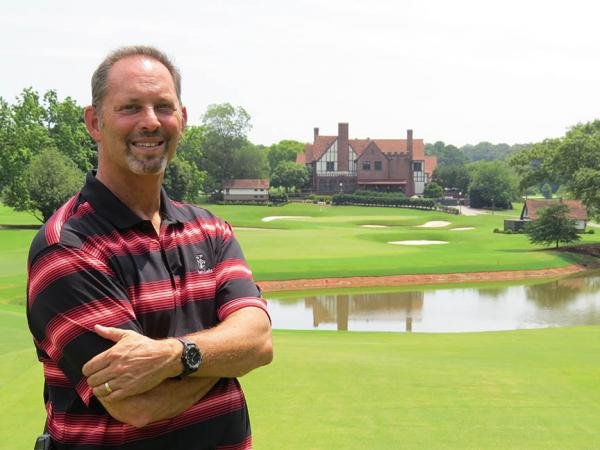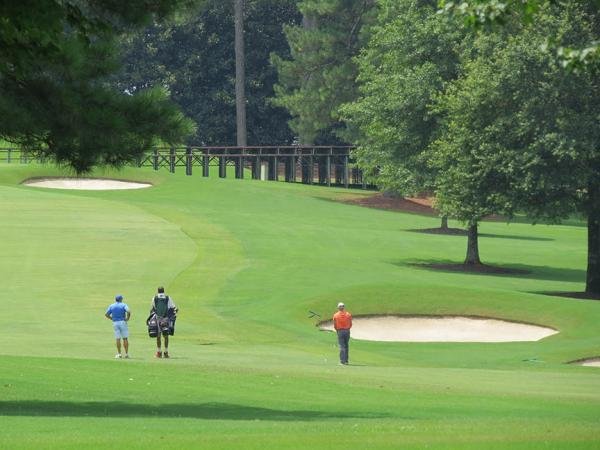East Lake Golf Club essentially is a giant bowl, with all holes arranged on a rectangular piece of land draining toward a lake in the center of the property. And for more than 100 years, the Atlanta club that was the home course of the great Bobby Jones has played the same way, ending on a challenging par-3 hole.
Until now. After years of deliberation, the PGA Tour decided during its 2015 Tour Championship that it was time to reverse the front and back nines at East Lake for this years tournament, scheduled for Sept. 22-25.
 The old front nine, which has been in place since Donald Ross reworked Tom Bendelow's original routing in 1913, now will be Nos. 10-18, and the old back nine now will be Nos. 1-9. No longer will rounds end on a par-3.
The old front nine, which has been in place since Donald Ross reworked Tom Bendelow's original routing in 1913, now will be Nos. 10-18, and the old back nine now will be Nos. 1-9. No longer will rounds end on a par-3.
"The PGA Tour was concerned there were not enough birdie opportunities on No. 18," Kepple said.
"They want a more volatile finish."
East Lake's old No. 6, a 160-yard par-3 with a water carry, historically is a place where a lot of movement, both up and down the leaderboard, takes place. Now, that hole - and the drama that occurs there - will be in the middle of the home stretch as the new No. 15.
"That is our most volatile hole," Kepple said. "There are double-bogeys and birdies there every year. I think they want that hole in the mix coming down the stretch.
"There are always a lot of people there. It's going to be very loud on that hole."
Changes also were made at the old No. 9, which will be 18 for the pros - and everyone else when the tournament is over. To entice everyone into the old risk-reward trap, the hole essentially was shortened by 10 yards by adding to the front of the championship tee. That means players who drive the ball over a plateau on the 550-yard par-5 will be within 240 yards of the green. A new fairway bunker along the right side was added to dissuade players from laying up. The changes not only will entice the shorter hitters to go for the green on their second shot, it also neutralizes a distinct advantage for the game's big hitters.
"It's a totally different way of looking at a golf hole," Kepple said.
The Tour has been contemplating a reversal of the East Lake nines for years, but always shelved the idea until last year. The decision has been welcomed by some of the top golfers. When Kepple, a pair of golf course architects and Tour officials were walking the course during a pre-tournament practice round last year, Justin Rose told the group to "add some teeth" to the golf course.
"That was the exact comment we needed to hear," Kepple said.
All changes were a joint effort between architects Rees Jones, who has been East Lake's go-to designer, and Steve Wenzloff, the PGA Tour's choice.
An elevated back left bunker almost gives golfers the feeling of a downhill shot out of the sand to a green that will be rolling at about 12.5 on the Stimpmeter.
"That's more difficult than a routine bunker shot," he said.
"There are more opportunities for things to happen and a more exciting finish, and I think that's what they were looking for."
It has been five years, when Bill Haas beat Hunter Mahan in a playoff in 2011, since anyone has come within three strokes of the winner.
Other changes in preparation for this year's Tour Championship are more difficult to detect, said Kepple, who is in his 24th season at East Lake.
The tee on No. 7 (new 16) was lowered and moved back 20 yards. Throw in a slight uphill grade in the fairway and the hole plays than its 440 yards and culminates at a green that breaks away to the back right..
"They've been hitting 9- or 8-iron into the that green. Now, they'll be hitting 5- to 7-irons," Kepple said. "The chances of drifting the ball right is much stronger and brings that green feature more into play."
The tee also was moved back 20 yards on No. 8 (new 17), and there was room to back an additional 10-20 yards.
 "These guys see a lot of golf courses, so they're not going to notice that a tee has been moved," Kepple said. "They might not notice the hole is longer until they hit drive and ask 'why am I still so far away from the green?' "
"These guys see a lot of golf courses, so they're not going to notice that a tee has been moved," Kepple said. "They might not notice the hole is longer until they hit drive and ask 'why am I still so far away from the green?' "
There are challenges ahead for Kepple and his crew as well. Just weeks after the Tour Championship, the top four men's and women's Division I golf teams will descend on Atlanta for the East Lake Cup match play event, scheduled for Oct. 31-Nov. 2.
By then, the Bermudagrass that has been covered by tournament infrastructure such as bleachers and hospitality venues, will be dead, and that's going to be a lot of turf. Only the Players Championship at TPC Sawgrass in Ponte Vedra Beach, Florida, has a larger infrastructure buildout than East Lake, says Kepple.
"They start building hospitality on July 1, and its not all down until October," he said. "Last year, NBC's compound for the East Lake Cup wasn't up until only a few days ahead of the tournament. Everything under that hospitality is dead, and you're bound to have some shots land in those areas. Then it shows up on TV and looks awful.
"That time of year is tough on our guys too. We put in a lot of hours, and only have a short down time after the Tour Championship before we have to get ready for the East Lake Cup. And we still have all those scars because it's the end of our growing season, and those scars don't get fixed until spring."
Kepple anticipates some tweaking after this year's event, and the Tour probably expects some, too, since no permanent utilities were run this year.
"The Tour is running everything on generators this year," he said.
"We're just trying to figure out where the hospitality works."
The reversing of the nines was implemented for member and guest play in August, and likely will stay that way in perpetuity.
"I don't think we'll ever switch the nines back," Kepple said. "Everyone will want to play as the pros played it."

